Tamaulipan mezquital
The Tamaulipan mezquital is a deserts and xeric shrublands ecoregion in the southern United States and northeastern Mexico. It covers an area of 141,500 km2 (54,600 sq mi),[2] encompassing a portion of the Gulf Coastal Plain in southern Texas, northern Tamaulipas, northeastern Coahuila, and part of Nuevo León.
| Tamaulipan mezquital Tamaulipan pastizal | |
|---|---|
.jpg) Mezquital habitat in Ciudad Victoria, Tamaulipas area. | |
 | |
| Ecology | |
| Realm | Nearctic |
| Biome | deserts and xeric shrublands |
| Borders | |
| Bird species | 340[1] |
| Mammal species | 90[1] |
| Geography | |
| Area | 141,500 km2 (54,600 sq mi) |
| Countries | Mexico and United States |
| States | Coahuila, Nuevo Leon, Tamaulipas and Texas |
| Conservation | |
| Habitat loss | 18.449%[1] |
| Protected | 0.68%[1] |
Distribution
The Sierra Madre Oriental range to the west separates the Tamaulipan mezquital from the drier Chihuahuan Desert. The Tamaulipan matorral is a transitional ecoregion between the mezquital and the Sierra Madre Oriental pine-oak forests to the west and the Veracruz moist forests to the south. The Western Gulf coastal grasslands, known as the Tamaulipan pastizal south of the border, fringe the Gulf of Mexico. The Edwards Plateau savannas lie to the north, and the East Central Texas forests and Texas blackland prairies to the northeast.[2]
Geography
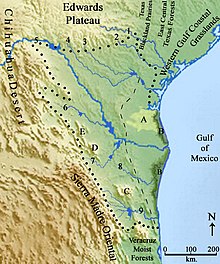
The Bordas Escarpment transects this ecoregion, running from near the southern limit northwest to the vicinity of Rio Grande City, Texas, arching back northeast to the vicinity of Choke Canyon Reservoir in Texas. The region east of the Bordas Escarpment is flat with deep, sandy soils, of which vast areas both north and south of the boarder have been converted to agricultural use. West of the Bordas Escarpment the topography changes to gently rolling hills with a thin layer of high calcium soil over a thick layer of caliche. Some large portions of the west are poorly suited for cultivation but good for ranching and excellent wildlife habitat.[3]
Hydrology: The region is generally semi-arid however, various wetlands are present. The Laguna Madre is one of only five hypersaline coastal lagoons (or negative estuaries) in the world and a significant ecosystem in itself, laying between the Gulf of Mexico and the Tamaulipan mezquital ecoregion.[4] As one moves inland from the hypersaline lagoon, a relatively narrow band of freshwater marshlands are encountered running north to south, albeit occurring fragmented and irregularly. These marshes are dynamic, fluctuating with rainfall and tropical storm activity, and alternating with wet and dry periods. When and where present, these marshlands can be locally, surprisingly extensive with deep marshes and both permanent and ephemeral freshwater ponds that support populations of salamanders (Sirens), turtles (Trachemys), and millions of migrating waterfowl, such as redheads (Aythya americana) in the winter.[5][6]
Several rivers cross the region, all flowing eastward to the Gulf of Mexico. Many of these river have created innumerable oxbow lakes, resacas, and abandoned channels with associated marshes and swamps as they meander across the flat coastal plain east of the Bordas Escarpment. The few remaining riparian zones in this region that have not been cleared for agriculture, housing, and industry, can support unexpectedly lush tropical jungle vegetation, particularly in the south.[2] The San Antonio River (a major tributary of the Guadalupe River) runs at the approximate northeastern border of this region. Other major rivers (north to south) include: the Nueces River and its tributary the Frio River; Rio Grande (referred to as Rio Bravo in Mexico) and its tributaries Rio Salado, Rio San Juan; the Rio San Fernando (sometimes called the Rio Conchos and not to be confused with the major drainage Rio Conchos of Chihuahua); the Rio Soto La Marina and its tributaries Rio San Carlos, Rio Pilón, San Antonio, Rio Purificacion, Rio Corona, Rio Santa Ana, form the approximate southern border.[7][8]
A number of large lakes occur in the region, but they were all constructed in the decades fallowing the Second World War in the 20th century. These include: Choke Canyon Reservoir and Lake Corpus Christi in the Nueces River drainage in the USA; Amistad International Reservoir and Falcon International Reservoir on the Rio Grande; Presa Venustiano Carranza in Coahuila on the Rio Salado, Presa El Cuchillo in Nuevo Leon and Presa Marte R. Gómez in Tamaulipas on the Rio San Juan, and Presa Vicente Guerrero in Tamaulipas on the Rio Soto La Marina drainage in Mexico.[7][8]
Tamaulipan mezquital gallery
.jpg) State Highway 16, Duval County, Texas, USA. (16 April 2016)
State Highway 16, Duval County, Texas, USA. (16 April 2016).jpg) Gravel road through Tamaulipan thornscrub, Webb County, Texas, USA (10 June 2016)
Gravel road through Tamaulipan thornscrub, Webb County, Texas, USA (10 June 2016).jpg) Gravel road through Tamaulipan thornscrub, Webb County, Texas, USA (10 June 2016)
Gravel road through Tamaulipan thornscrub, Webb County, Texas, USA (10 June 2016)%2C_FM_1017%2C_Jim_Hogg_County%2C_Texas%2C_USA_(10_April_2016).jpg) Wild Olive (Cordia boissieri), FM 1017, Jim Hogg County, Texas, USA (10 April 2016)
Wild Olive (Cordia boissieri), FM 1017, Jim Hogg County, Texas, USA (10 April 2016).jpg) A resaca in Estero Llano Grande State Park, Hidalgo County, Texas, USA (13 April 2016)
A resaca in Estero Llano Grande State Park, Hidalgo County, Texas, USA (13 April 2016).jpg) Tamaulipan thornscrub, State Highway 4, Cameron Cameron County, Texas, USA (11 April 2016)
Tamaulipan thornscrub, State Highway 4, Cameron Cameron County, Texas, USA (11 April 2016).jpg) Trail through mature thornscrub forest in Santa Ana National Wildlife Refuge, Hidalgo County, Texas, USA (14 April 2016).
Trail through mature thornscrub forest in Santa Ana National Wildlife Refuge, Hidalgo County, Texas, USA (14 April 2016)..jpg) Bentsen-Rio Grande Valley State Park, Hidalgo County, Texas, USA (15 April 2016)
Bentsen-Rio Grande Valley State Park, Hidalgo County, Texas, USA (15 April 2016).jpg) Road in thornscrub vegetation, Yturria Brush National Wildlife Refuge, Hidalgo County, Texas, USA (15 April 2016)
Road in thornscrub vegetation, Yturria Brush National Wildlife Refuge, Hidalgo County, Texas, USA (15 April 2016).jpg) Rio Grande southeast of Falcon Reservoir, Municipality of Mier, Tamaulipas, Mexico (12 August 2007)
Rio Grande southeast of Falcon Reservoir, Municipality of Mier, Tamaulipas, Mexico (12 August 2007).jpg) Thornscrub south of Reynosa, Municipality of Reynosa, Tamaulipas, Mexico (13 August 2007)
Thornscrub south of Reynosa, Municipality of Reynosa, Tamaulipas, Mexico (13 August 2007).jpg) Sierra San Carlos, Municipality of San Carlos, Tamaulipas, Mexico (14 July 2007)
Sierra San Carlos, Municipality of San Carlos, Tamaulipas, Mexico (14 July 2007)%2C_Municipality_of_San_Carlos%2C_Tamaulipas%2C_Mexico_(12_July_2007).jpg) Sierra San Carlos, with a pine tree (Pinus teocote) on left, Municipality of San Carlos, Tamaulipas, Mexico (12 July 2007)
Sierra San Carlos, with a pine tree (Pinus teocote) on left, Municipality of San Carlos, Tamaulipas, Mexico (12 July 2007).jpg) Thornscrub ranchland west of Tepehuajes, Municipio Soto La Marina, Tamaulipas, Mexico (20 May 2002)
Thornscrub ranchland west of Tepehuajes, Municipio Soto La Marina, Tamaulipas, Mexico (20 May 2002)
Protected areas
Nature preserves are numerous in the region, however many are relatively small tracts of land concentrated on the north side of the Lower Rio Grande Valley. The state of Texas administers the following lands in the Lower Rio Grande Valley: Lake Casa Blanca International State Park (525-acres); Falcon State Park (576 acres); Bentsen-Rio Grande Valley State Park (764 acres); Estero Llano Grande State Park (230 acres); Resaca de la Palma State Park (1,200 acres); and the Las Palomas Wildlife Management Area comprised 18 units with tracts ranging from two to 604 acres (3,311 acres total).[9] The U. S. Federal Government also administers lands in the Lower Rio Grande Valley including the Santa Ana National Wildlife Refuge (2,088 acres) and western and higher elevation areas of the Laguna Atascosa National Wildlife Refuge on the Gulf Coast (>97, 000 acres). The multi-unit Lower Rio Grande Valley National Wildlife Refuge has nearly 40,000 acres open to the public [e.g. the Boca Chica tract (10,680-acres), East Lake unit (1,700 acres), La Puerta unit (4,000 acres), Teniente Lake unit (5,600 acres), Yturria Brush unit (1,800 acres)] and an additional 6,000 acres open to hunting [as of 2020].[10] Also of note is the Sabal Palm Sanctuary (557-acres), cooperatively manage by the Gorgas Science Foundation and the National Audubon Society, preserving some of the finest old growth riparian zones and sabal palm groves (Sabal mexicana) remaining.
Beyond the Lower Rio Grande Valley of Texas protected lands include the Chaparral Wildlife Management Area (15,200 acres) and Choke Canyon State Park: including the Calliham unit (1,100 acres), the South Shore unit (385-acres), and the adjoining James E. Daughtrey Wildlife Management Area (34,000 acres).
In Tamaulipas, Mexico protected areas include western portions of the Laguna Madre y Delta del Rio Bravo and Parras de la Fuente, Reserva de la Paloma de Ala Blanca (ca. 23.8888°N, 98.5000°W), and in Coahuila, Mexico the Parque Nacional Los Novillos. Many of the protected lands in Mexico are actually "paper parks" owned and administer by local ejidos and municipalities, with few resources devoted to their management, no accommodations, no facilities or trails for visitors, and little management or enforcement of wildlife regulations. Nonetheless, such parks do limit land usage and development, and thus provide a significant degree of protection for habitat and the flora and fauna within.[11][12][13]
Flora
%2C_Rio_Pil%C3%B3n_near_Villagr%C3%A1n%2C_Municipality_of_Villagr%C3%A1n%2C_Tamaulipas%2C_Mexico_(9_August_2005).jpg)
Mezquital is characterized by honey mesquite (Prosopis glandulosa) and curly mesquite grass (Hilaria belangeri). Prior to disturbance, the most common shrubs were probably lotebush (Ziziphus obtusifolia) and whitebrush (Aloysia gratissima).
Parts of this region consisted of open woods of mesquite, with a pronounced understory of grasses. The grasses in this community contained a layer of taller species such as hooded windmill grass (Chloris cucullata) and fourflower trichloris (Trichloris pluriflora), and a layer of shorter species such as grama (Bouteloua spp.). In some places dense stands of Texas prickly pear (Opuntia engelmannii var. lindheimeri) occurred instead of shrubs and grasses.
Brushy species include huisache (Vachellia farnesiana var. farnesiana), blackbrush (Vachellia rigidula) and other acacias, desert hackberry or granjeno (Celtis pallida), cenizo (Leucophyllum frutescens), whitebrush, Texas prickly pear, and tasajillo (Cylindropuntia leptocaulis).
Mexican palmettos (Sabal mexicana) and Montezuma cypresses (Taxodium mucronatum) grow in riparian zones, such as along the Rio Grande.[2]
%2C_State_Highway_4%2C_Cameron_County%2C_Texas%2C_USA_(11_April_2016).jpg)
Cacti: This region is rich in cacti diversity. A few species found in the province include: root cactus (Sclerocactus [=Acanthocereus] scheeri), triangle or barbed wire cactus (Acanthocereus tetragonus), star cactus (Astrophytum asterias), Berlandier's hedgehog (Echinocereus berlandieri), pitaya (Echinocereus enneacanthus var. brevispinus), Allicoche hedgehog cactus (Echinocereus papillosus), ladyfinger hedgehog (Echinocereus pentalophus), Dahlia cactus (Echinocereus poselgeri), Junior Tom Thumb cactus (Escobaria emskoetteraana), Turk's head barrel cactus (Ferocactus hamatacanthus var. sinuatus), peyote (Lophophora williamsii), Heyder's pincushion cactus (Mammillaria heyderi), hair-covered cactus or Texas pincushion (Mammillaria prolifera var. texana), pale mammillaria (Mammillaria sphaerica), twisted rib cactus (Thelocactus setispinus) and several others.[14]
Fauna
Mammals: This region once hosted an impressive number of carnivores but, most were very rare, or entirely extirpated by the early to mid 20th century. The gray wolf (Canis lupus) is extirpated and black bears (Ursus americanus) are now largely restricted to the Sierra de Picachos in Nuevo Leon, Mexico.[15] The most recent records of the jaguar (Panthera onca) in Texas, USA are from the early 1950s, but the species still lingers, although at risk of extinction in Mexico. Similarly, jaguarondi (Herpailurus yaguarondi), ocelot (Leopardus pardalis), and margay (Leopardus wiedii) are all threatened or endangered in the USA and Mexico. Some puma or mountain lion (Puma concolor), White-nosed coati (Nasua narica), and American Badger (Taxidea taxus) populations still persist, apparently in stable numbers in some remote areas, although the latter is considered a threatened species in Mexico. A few other species such as the Northern Raccoon (Procyon lotor), Coyote (Canis latrans), and to a lesser extent Bobcats (Lynx rufus) have adapted to human encroachment and development.[16][17]
Other mammals found in the region include the collared peccary (Pecari tajacu), white-tailed deer (Odocoileus virginianus), black-tailed jackrabbit (Lepus californicus), nine-banded armadillo (Dasypus novemcinctus), Mexican long-tongued bat (Choeronycteris mexicana), and the southern yellow bat (Lasiurus ega). Rodents include the predatory northern grasshopper mouse (Onychomys leucogaster), the Mexican prairie dog (Cynomys mexicanus), Rio Grande ground squirrel (Ictidomys parvidens) and others such as Coue's rice rat (Oryzomys couesi), southern plains woodrat (Neotoma micropus), Mexican spiny pocket mouse (Liomys irroratus), and Merriam's pocket mouse (Perognathus merriami).[16][17]
%2C_Bentsen-Rio_Grande_Valley_State_Park%2C_Hidalgo_Co._Texas_(4_Feb_2010)._A.jpg) Collared peccary (Pecari tajacu), Hidalgo Co. Texas (4 Feb 2010).
Collared peccary (Pecari tajacu), Hidalgo Co. Texas (4 Feb 2010)._Cameron_Co._Texas_(12_April_2016).jpg) Rio Grande ground squirrel (Ictidomys parvidens) Cameron Co. Texas (12 April 2016).
Rio Grande ground squirrel (Ictidomys parvidens) Cameron Co. Texas (12 April 2016). Black-tailed jackrabbit (Lepus californicus), Texas (13 June 2006).
Black-tailed jackrabbit (Lepus californicus), Texas (13 June 2006)._Laguna_Atascosa_National_Wildlife_Refuge%2C_Texas.jpg) Ocelot (Leopardus pardalis) with tracking caller, Laguna Atascosa National Wildlife Refuge, Cameron Co. Texas.
Ocelot (Leopardus pardalis) with tracking caller, Laguna Atascosa National Wildlife Refuge, Cameron Co. Texas..jpg) Mexican long-tongued bat (Choeronycteris mexicana).
Mexican long-tongued bat (Choeronycteris mexicana). White-nosed coati (Nasua narica), Mexico (5 Sept 2009).
White-nosed coati (Nasua narica), Mexico (5 Sept 2009)._cropped.jpg) American badger (Taxidea taxus), Marin, California (25 Nov 2007).
American badger (Taxidea taxus), Marin, California (25 Nov 2007).
Birds: The southern part of the ecoregion is an Endemic Bird Area[18] and is home to the red-crowned amazon (Amazona viridigenalis), tawny-collared nightjar (Caprimulgus salvini), Tamaulipas crow (Corvus imparatus), long-billed thrasher (Toxostoma longirostre), Altamira yellowthroat (Geothlypis flavovelata), crimson-collared grosbeak (Rhodothraupis celaeno). Other species occurring in this region include the white-tailed hawk (Buteo albicaudatus), plain chachalaca (Ortalis vetula), green parakeet (Psittacara holochlorus), buff-bellied hummingbird (Amazilia yucatanensis), Couch's kingbird (Tyrannus couchii), and Audubon's oriole (Icterus graduacauda) as well as wide ranging tropical species such as the green jay (Cyanocorax yncas), least grebe (Tachybaptus dominicus), Ferruginous pygmy owl (Glaucidium brasilianum), ringed kingfisher (Megaceryle torquata), and the great kiskadee (Pitangus sulphuratus).[2][19][20]
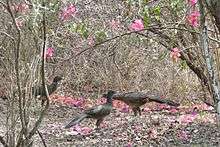 Plain chachalaca (Ortalis vetula), Municipality of Montemorelos, Nuevo León (9 April 2009).
Plain chachalaca (Ortalis vetula), Municipality of Montemorelos, Nuevo León (9 April 2009)..jpg) Red-crowned Amazon (Amazona viridigenalis), Cameron Co. Texas (15 Mar 2016).
Red-crowned Amazon (Amazona viridigenalis), Cameron Co. Texas (15 Mar 2016)..jpg) Ferruginous pygmy owl (Glaucidium brasilianum), King Ranch, TX (15 Mar 2016).
Ferruginous pygmy owl (Glaucidium brasilianum), King Ranch, TX (15 Mar 2016)._Sabal_Palm_C.jpg) Buff-bellied hummingbird (Amazilia yucatanensis), Sabal Palm Sanctuary, Cameron Co. Texas (21 Sept. 2015).
Buff-bellied hummingbird (Amazilia yucatanensis), Sabal Palm Sanctuary, Cameron Co. Texas (21 Sept. 2015). Great kiskadee (Pitangus sulphuratus). Bee Co., Texas (3 July 2011).
Great kiskadee (Pitangus sulphuratus). Bee Co., Texas (3 July 2011)..jpg) Long-billed thrasher (Toxostoma longirostre), Texas, USA (20 Feb. 2017).
Long-billed thrasher (Toxostoma longirostre), Texas, USA (20 Feb. 2017).
Reptiles: The American alligator (Alligator mississippiensis) and the red-eared slider (Trachemys scripta) occur in the north of this region and the Morelet’s crocodile (Crocodylus moreletii) and Mesoamerican slider (Trachemys venusta) in the south. Other turtles such as the Mexican box turtle (Terrapene mexicana), Rio Grande cooter (Pseudemys gorzugi), spiny softshell (Apalone spinifera), and the yellow mud turtle (Kinosternon flavescens) occur there. The geographic distribution of the Texas tortoise (Gopherus berlandieri) nearly matches that of the Tamaulipan mezquital ecoregion. The Laredo striped whiptail (Aspidoscelis laredoensis) is a species complex of all female lizards that reproduce by parthenogenesis that is endemic to this region. The reticulate collared lizard (Crotaphytus reticulatus) is also endemic. Other representative lizards include the Texas banded gecko (Coleonyx brevis), four-lined skink (Plestiodon tetragrammus), common spotted whiptail (Aspidoscelis gularis), keeled earless lizard (Holbrookia propinqua), Texas horned lizard (Phrynosoma cornutum), blue spiny lizard (Sceloporus cyanogenys), and the northern rose-belly lizard (Sceloporus variabilis marmoratus), regarded by some as a full species (Sceloporus marmoratus). Some representative snakes of the Tamaulipan mezquital include the Tamaulipan hook-nose snake (Ficimia streckeri), Mexican milksnake (Lampropeltis annulata), and Schott’s whipsnake (Masticophis schotti). More wide ranging species include the Great Plains ratsnake (Pantherophis emoryi), gopher snake (Pituophis catenifer), long-nose snake (Rhinocheilus lecontei), and eastern patch-nose snake (Salvadora grahamiae). Some tropical species reaching the northern margin of their ranges including the regal black-striped snake (Coniophanes imperialis), Central American indigo snake (Drymarchon melanurus), speckled racer (Drymobius margaritiferus), northern cat-eyed Snake (Leptodeira septentrionalis). Venoumous snakes include the Texas coralsnake (Micrurus tener) and western diamond-back rattlesnake (Crotalus atrox), with the western massasauga rattlesnake (Sistrurus tergeminus) occurring in the north and the Totonacan rattlesnake (Crotalus totonacus) occurring in the south.[21][22]
 Rose-bellied lizard (Sceloporus variabilis marmoratus), Hidalgo County, Texas, USA (14 April 2016).
Rose-bellied lizard (Sceloporus variabilis marmoratus), Hidalgo County, Texas, USA (14 April 2016).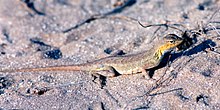 Keeled earless lizard (Holbrookia propinqua), municipality of Soto La Marina, Tamaulipas, Mexico (20 May 2002).
Keeled earless lizard (Holbrookia propinqua), municipality of Soto La Marina, Tamaulipas, Mexico (20 May 2002).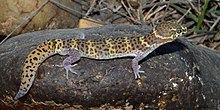 Texas banded gecko (Coleonyx brevis), Webb County Texas, USA (10 June 2016).
Texas banded gecko (Coleonyx brevis), Webb County Texas, USA (10 June 2016). Texas Tortoise (Gopherus berlandieri), northern Tamaulipas, Mexico (9 July 2007).
Texas Tortoise (Gopherus berlandieri), northern Tamaulipas, Mexico (9 July 2007).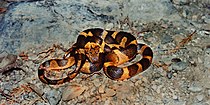 Northern cat-eyed snake (Leptodeira septentrionalis), Municipality of Victoria, Tamaulipas, Mexico (7 Aug 2003).
Northern cat-eyed snake (Leptodeira septentrionalis), Municipality of Victoria, Tamaulipas, Mexico (7 Aug 2003).%2C_Municipality_of_Victoria%2C_Tamaulipas_(30_Oct_2003).jpg) Mexican milksnake (Lampropeltis annulata), Municipality of Victoria, Tamaulipas (30 Oct 2003).
Mexican milksnake (Lampropeltis annulata), Municipality of Victoria, Tamaulipas (30 Oct 2003).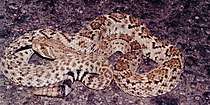 Western diamondback rattlesnake (Crotalus atrox), Municipality of Padilla, Tamaulipas, Mexico (29 May 2004).
Western diamondback rattlesnake (Crotalus atrox), Municipality of Padilla, Tamaulipas, Mexico (29 May 2004).
Amphibians: In spite of the semi-arid environment, enough wetlands are present to support salamanders such as the black-spotted newt (Notophthalmus meridionalis) and the lesser siren (Siren intermedia). A second species of siren is known to occur in the lower Rio Grande, thought to be a distant and isolated population of the greater siren (Siren lacertina) by some, or an undescribed species by others. The Rio Grande leopard frog (Lithobates berlandieri) and western narrow-mouthed toad (Gastrophryne olivacea) occur in the region along with several toads (Bufonidae) inhabiting the thorn scrub and grasslands including the green toad (Anaxyrus debilis), Texas toad (Anaxyrus speciosus), Gulf Coast toad (Incilius nebulifer), and cane toad (Rhinella horribilis). Many tropical species reach the northern limits of their distributions there such as the Mexican treefrog (Smilisca baudinii), white-lipped frog (Leptodactylus fragilis), sheep frog (Hypopachus variolosus), and the unusual burrowing toad (Rhinophrynus dorsalis), so unique it is classified in a family (Rhinophrynidae) by itself.[21]
 Mexican Treefrog (Smilisca baudinii), Municipality of Abasolo, Tamaulipas, Mexico (18 May 2002).
Mexican Treefrog (Smilisca baudinii), Municipality of Abasolo, Tamaulipas, Mexico (18 May 2002).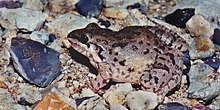 White-lipped Frog (Leptodactylus fragilis) Municipality of Victoria, Tamaulipas, Mexico (12 August 2003).
White-lipped Frog (Leptodactylus fragilis) Municipality of Victoria, Tamaulipas, Mexico (12 August 2003).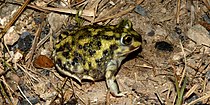 Couch’s Spadefoot (Scaphiopus couchii), Cameron County, Texas, USA (11 April 2016).
Couch’s Spadefoot (Scaphiopus couchii), Cameron County, Texas, USA (11 April 2016).%2C_Santa_Ana_NWR%2C_Hidalgo_Co%2C_TX%2C_USA%2C_(26.0821%C2%B0N%2C_98.1354%C2%B0W)%2C_14_April_2016.jpg) Black-spotted Newt (Notophthalmus meridionalis), Santa Ana NWR, Hidalgo Co, Texas (14 April 2016).
Black-spotted Newt (Notophthalmus meridionalis), Santa Ana NWR, Hidalgo Co, Texas (14 April 2016).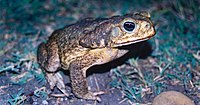 Cane Toad (Rhinella horribilis), Municipality of Soto La Marina, Tamaulipas, Mexico (17 May 2002).
Cane Toad (Rhinella horribilis), Municipality of Soto La Marina, Tamaulipas, Mexico (17 May 2002).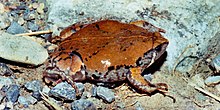 Sheep Frog (Hypopachus variolosus), Municipality of Victoria, Tamaulipas, Mex (12 August 2003).
Sheep Frog (Hypopachus variolosus), Municipality of Victoria, Tamaulipas, Mex (12 August 2003).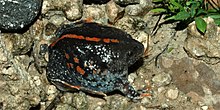 Burrowing Toad (Rhinophrynus dorsalis), Municipality of Reynosa, Tamaulipas, Mexico (8 October 2007).
Burrowing Toad (Rhinophrynus dorsalis), Municipality of Reynosa, Tamaulipas, Mexico (8 October 2007).
Fishes: Two species, the San Ignacio pupfish (Cyprinodon bobmilleri) from the upper Rio San Fernando basin near Linares and the swordtail platyfish (Xiphophourus xiphidium) occurring in the upper parts of the Rio Soto La Maria, in Tamaulipas are endemic to this region. The Amazon molly (Poecilia formosa), is a unisexual (all female) species that reproduces through gynogenesis, a form of a form of parthenogenesis. Other fishes found in the area are alligator gar (Atractosteus spatula), longnose gar (Lepisosteus osseus), Rio Grande cichlid (Herichthys cyanoguttatus), sailfin molly (Poecilia latipinna), Rio Grande silvery minnow (Hybognathus amarus), San Juan minnow (Dionda couchi), Tamaulipas shiner (Notropis braytoni), Rio Grande shinner (Notropis jemezanus), Gulf killifish (Fundulus grandis), and Rio Grande darter (Etheostoma grahami). Two endemic species from this region, the phantom shinner (Notropis orca) and the Salado shinner (Notropis saladonis), are believed to be extinct.[23][24][25]
 Sailfin molly (Poecilia latipinna)
Sailfin molly (Poecilia latipinna) Rio Grande darter (Etheostoma grahami), Val Verde Co., Texas (22 June 2006).
Rio Grande darter (Etheostoma grahami), Val Verde Co., Texas (22 June 2006).%2C_male%2C_Dixie_Co%2C_Florida_(27_Dec_2013).jpg) Gulf killifish (Fundulus grandis), male, Dixie Co., Florida.
Gulf killifish (Fundulus grandis), male, Dixie Co., Florida. Rio Grande silvery minnow (Hybognathus amarus)
Rio Grande silvery minnow (Hybognathus amarus)_II.jpg) Rio Grande cichlid (Herichthys cyanoguttatus), Texas
Rio Grande cichlid (Herichthys cyanoguttatus), Texas.jpg) Longnose gar (Lepisosteus osseus)
Longnose gar (Lepisosteus osseus)_I.jpg) Alligator gar (Atractosteus spatula)
Alligator gar (Atractosteus spatula)
References
- Hoekstra, J. M.; Molnar, J. L.; Jennings, M.; Revenga, C.; Spalding, M. D.; Boucher, T. M.; Robertson, J. C.; Heibel, T. J.; Ellison, K. (2010). Molnar, J. L. (ed.). The Atlas of Global Conservation: Changes, Challenges, and Opportunities to Make a Difference. University of California Press. ISBN 978-0-520-26256-0.
- "Tamaulipan mezquital". Terrestrial Ecoregions. World Wildlife Fund. Retrieved 2010-11-25.
- Fulbright, Timothy E., and Fred C. Bryant (2004).The Last Great Habitat. A Special Publication of the Caesar Kleberg Wildlife Research Institute, Texas A&M University-Kingsville. Special Publication No. 1, 1-32 pp.
- Tunnell, Jr. John W. and Frank W. Judd. editors. (2002). The Laguna Madre of Texas and Tamaulipas. Texas A&M University Press, College Station, Texas. xxi, 346 pp. ISBN 1-58544-133-3
- Smith, Elizabeth H. (2002). Redheads and Other Wintering Waterfowl. 169-181 pp. In Tunnell, Jr. John W. and Frank W. Judd. (editors). The Laguna Madre of Texas and Tamaulipas. Texas A&M University Press, College Station, Texas. xxi, 346 pp. ISBN 1-58544-133-3
- Farr, William L. (2015). Herpetofauna of Tamaulipas. 101-121 pp. In. Lemos Espinal, J. A. (Editor). Amphibians and Reptiles of the US-Border States. Texas A&M University Press. College Station, Texas. x, 614 pp. ISBN 978-1-62349-306-6
- Texas Water Development Board, TWDB Maps: Major Surface Water Features.
- Agustin Palacios Roji Grcía and Joaquin Palacios Roji Grcía. (2007). Por Las Carreteras de México. Guia Roji, S.A. de C. V. México, D. F., Mexico. 151 pp. ISBN 970-621-492-5
- Texas Parks and Wildlife: Las Palomas WMA, Lower Rio Grande Valley Units
- U. S. Fish and Wildlife Service: Lower Rio Grande Valley National Wildlife Refuge, Texas
- UNESCO: Laguna Madre y Delta Río Bravo
- Gobierno del Estado de Tamaulipas: Paloma Alas Blancas
- Gobierno del México: 76 aniversario del Parque Nacional Los Novillos
- Loflin, Brian and Shirley Loflin. (2009). Texas Cacti. Texas A&M University Press, College Station. xv, 291. ISBN 978-1-60344-108-7
- World Wildlife Fund, ed. (2001). "Tamaulipan mezquital". WildWorld Ecoregion Profile. National Geographic Society. Archived from the original on 2010-03-08. Retrieved 2010-11-25.
- Schmidly, D. J. (2004). The Mammals of Texas. [Sixth Edition]. University of Texas Press, Austin, Texas. xviii, 501 pp. ISBN 0-292-70241-8
- Ceballos, G. Ed. (2014). Mammals of Mexico. Johns Hopkins University Press. Baltimore, Maryland. xiii, 957 pp. ISBN 1-4214-0843-0
- Stattersfield, A.J., M.J. Crosby, A.J. Long and D.C. Wege. (1998). Endemic Bird Areas of the World: Priorities for Biodiversity Conservation. Birdlife Conservation Series No. 7, Cambridge, UK.
- Howell, S. N. G. and S. Webb. (1995). A Guide to the Birds of Mexico and Northern Cantral America. Oxford University Press. Oxford. xvi, 851 pp. ISBN 0-19-854012-4
- Terres, J. K. (1996). The Audubon Society Encyclopedia of North American Birds. Wings Books, a dicision of Random House Value Publishing, Inc.. New York. N. Y. 1109 pp. ISBN 0-517-03288-0
- Lemos Espinal, J. A., Editor. (2015). Amphibians and Reptiles of the US-Mexico Border States. Texas A&M University Press. College Station, Texas. x, 614 pp. ISBN 978-1-62349-306-6
- Werler, J. E. and J. R. Dixon. (2000). Texas Snakes, Identification, Distribution, and Natural History. University of Texas Press, Austin, Texas. xv, 437 pp. ISBN 0-292-79130-5
- García de León, Francisco J., Delladira Gutiérrez Tirado, Dean A. Hendrickson, and Héctor Espinosa Pérez (2005). Fishes of the Continental Waters of Tamaulipas: Diversity and Conservation Status. In Jean-Luc E. Cartron, Gerardo Ceballos, and Richard S. Felger (eds.). Biodiversity, Ecosystems, and Conservation in Northern Mexico. Oxford University Press, Inc. New York, N. Y. xvi, 496 pp. ISBN 0-19-515672-2
- Miller, R. R., W. L. Minckley, and S. M. Norris. (2005). Freshwater Fishes of Mexico. University of Chicago Press. Chicago, Illinois. xxv, 490 pp. ISBN 0-226-52604-6
- Thomas, Chad, Timothy H. Bonner, & Bobby G. Whiteside. (2007). Freshwater Fishes of Texas: A Field Guide. Texas A&M University Press. College Station, Texas. xiv, 202 pp. ISBN 978-1-58544-570-7